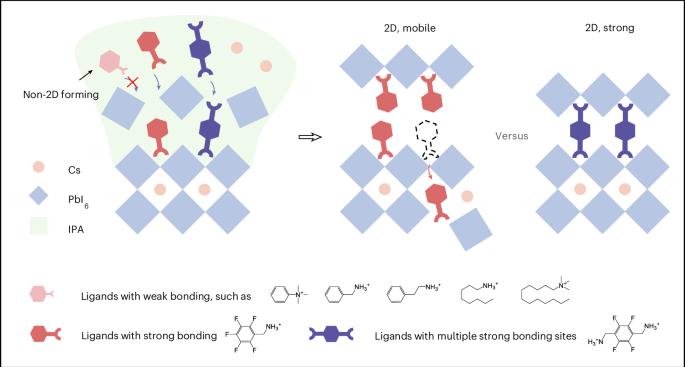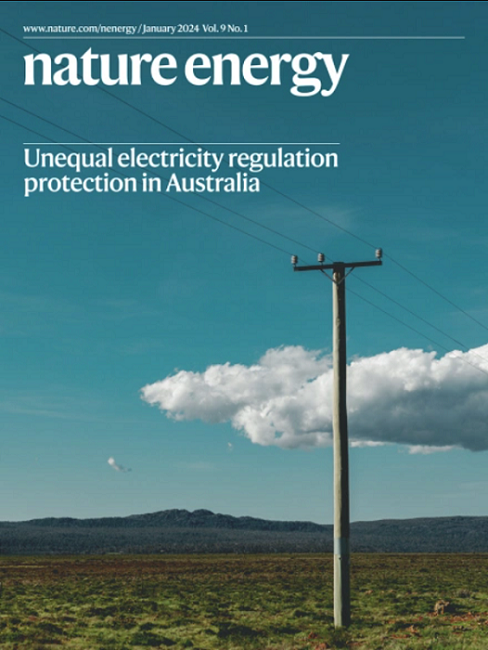Cation interdiffusion control for 2D/3D heterostructure formation and stabilization in inorganic perovskite solar modules
IF 60.1
1区 材料科学
Q1 ENERGY & FUELS
引用次数: 0
Abstract
Inorganic perovskite solar cells could benefit from surface passivation using 2D/3D perovskite heterostructures. However, conventional spacer cations fail to exchange with the tightly bonded Cs cation in the inorganic perovskite to form 2D layers atop; or, when they do enable formation of a 2D layer, they migrate under heat, degrading device performance. Here we investigate the mechanisms behind 2D/3D heterostructure formation and stabilization. We find that 2D/3D heterostructure formation is driven by interactions between ammonium groups and [PbI6]4− octahedra. We thus incorporate electron-withdrawing fluorine to enhance inorganic–organic cation interdiffusion and promote heterostructure formation. We note that stability relies on interactions between the entire spacer cations and [PbI6]4− octahedra. We therefore introduce anchoring groups that double cation desorption energies, preventing cation migration at elevated temperatures. CsPbI3/(perfluoro-1,4-phenylene)dimethanammonium lead iodide heterostructures enable an efficiency of 21.6% and a maximum power point operating stability at 85 °C of 950 h. We demonstrate 16-cm2 modules with an efficiency of 19.8%. The formation of 2D perovskites in inorganic perovskite solar cells is hindered by the strong binding affinity of caesium ions. Liu et al. engineer the functional groups of a large organic cation to facilitate its exchange with caesium ions and form a stable 2D perovskite.


无机钙钛矿太阳能组件中2D/3D异质结构形成和稳定的阳离子互扩散控制
无机钙钛矿太阳能电池可以受益于使用二维/三维钙钛矿异质结构的表面钝化。然而,传统的间隔阳离子不能与无机钙钛矿中紧密结合的Cs阳离子交换,形成2D层;或者,当它们能够形成2D层时,它们会在高温下迁移,从而降低设备性能。在这里,我们研究了2D/3D异质结构形成和稳定的机制。我们发现二维/三维异质结构的形成是由铵基和[PbI6]4−八面体之间的相互作用驱动的。因此,我们加入吸电子氟来增强无机-有机阳离子的相互扩散和促进异质结构的形成。我们注意到稳定性依赖于整个间隔阳离子和[PbI6]4−八面体之间的相互作用。因此,我们引入了锚定基团,使阳离子解吸能加倍,防止阳离子在高温下迁移。CsPbI3/(全氟-1,4-苯基)二甲基铵碘化铅异质结构使效率达到21.6%,在85°C时最大功率点工作稳定性为950小时。我们演示了16平方厘米的模块,效率为19.8%。
本文章由计算机程序翻译,如有差异,请以英文原文为准。
求助全文
约1分钟内获得全文
求助全文
来源期刊

Nature Energy
Energy-Energy Engineering and Power Technology
CiteScore
75.10
自引率
1.10%
发文量
193
期刊介绍:
Nature Energy is a monthly, online-only journal committed to showcasing the most impactful research on energy, covering everything from its generation and distribution to the societal implications of energy technologies and policies.
With a focus on exploring all facets of the ongoing energy discourse, Nature Energy delves into topics such as energy generation, storage, distribution, management, and the societal impacts of energy technologies and policies. Emphasizing studies that push the boundaries of knowledge and contribute to the development of next-generation solutions, the journal serves as a platform for the exchange of ideas among stakeholders at the forefront of the energy sector.
Maintaining the hallmark standards of the Nature brand, Nature Energy boasts a dedicated team of professional editors, a rigorous peer-review process, meticulous copy-editing and production, rapid publication times, and editorial independence.
In addition to original research articles, Nature Energy also publishes a range of content types, including Comments, Perspectives, Reviews, News & Views, Features, and Correspondence, covering a diverse array of disciplines relevant to the field of energy.
 求助内容:
求助内容: 应助结果提醒方式:
应助结果提醒方式:


